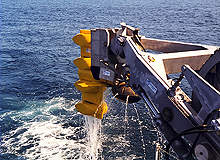
Sonar technology is constantly adapting to the ever-changing demands of modern naval combat. Over the years, debates on the merits of active versus passive sonar have shifted to and fro as navies attempt to work out which systems have become obsolete in the face of advances in other areas. As such, the issue of interoperability and creating flexible systems has been pushed to the forefront.
Peter Don-Duncan is the engineering director of sonar at Thales UK. With 30 years’ experience in the field of sonar development, he has been well-placed to track the advances of this vital technology. Thales recently won a contract from BAE Systems to upgrade sonar systems on three Trafalgar Class and three Astute Class Royal Navy submarines, so we tracked Don-Duncan down to find out about the new system and the latest developments in the naval sonar field.
Chris Lo: How has sonar advanced in the last ten years? What have been the major improvements to the technology?
Peter Don-Duncan: The major improvements in sonar technology have been the development of step-change higher performance array technologies coupled with the introduction of inboard high-processing capacity COTS [commercial-off-the-shelf] open architecture technology. The latter has facilitated more rapid capability insertion. The higher processing capacity of current COTS processing engines has allowed the introduction of much more capable and sophisticated sonar algorithms compared with previous generation sonar.
CL: Obviously submarines and surface ships use sonar in different ways – how does this affect the technology within sonar systems in the respective types of vessel?
PDD: Some array technology is necessarily specific to the type of platform. However, there is more commonality than you might think. For example, towed arrays can be common between submarines and surface ships and indeed this is the case with some existing in-service sonars. Also, there is commonality of some transducer technology given that they operate at similar sonar frequencies.
CL: In February, Thales UK announced that it had been contracted to install the sonar 2076 stage 5 system on six Royal Navy submarines. Could you describe the technical improvements of this system and its new capabilities?
PDD: The major improvement introduced by the stage 5 system is that is has been designed as an open architecture system utilising the current state-of-the-art IT industry COTS processing. This has already facilitated the introduction of third-party algorithm insertions from SMEs.
CL: What is the status of the new system’s deployment and the Royal Navy upgrade programme in general?
PDD: The new system has already been fitted to the first platform and the rollout to the remainder of platforms is scheduled to be complete within the next two years.
CL: How does the new stage 5 system improve the through-life cost of the device?
PDD: The main contributor to through-life cost reduction is the use of COTS processors together with the consequent reduction in the number of card types.
CL: In what ways can a sonar system provide the flexibility to be able to adapt to ever-changing mission requirements?
PDD: The open architecture design of modern sonar, such as S2076 stage 5, facilitates rapid capability insertion. This allows new algorithms to be inserted with minimal impact on the rest of the system. The advent of general-purpose COTS processors has also made it much easier to enhance the hardware of OA systems. This can be done by using either the latest higher speed processors or simply extending the processing power whilst minimising the impact on the software. The application software used in sonar 2076 stage 5 is basically hardware agnostic.
CL: What do you think modern navies expect from today’s sonar devices?
PDD: The key aspect is maintaining a range advantage against the threat and to achieve what is necessary to maximise the performance of the arrays.
Thales has invested heavily in world-leading sonar array technology, which is now in service with S2076, the surface ship low-frequency active sonar 2087, the sonar 2193 mine warfare wideband array technology and the sonar 2089 helicopter active dipping sonar. The introduction of high-performance arrays increases the amount of data potentially available to the operators. Thales has also invested in state-of-the-art HCI technology and operator visualisation.
CL: Given the March 2010 sinking of South Korean warship ROKS Cheonan after an alleged submarine attack, how important do you think it is to see the latest sonar technology adopted on surface ships around the world? Do you think there is a particularly striking sonar technology gap between submarines and warships?
PDD: There are world-leading technologies already available for both submarines and surface ships. The issue is more to do with what technology current navies have access to or indeed can afford.




